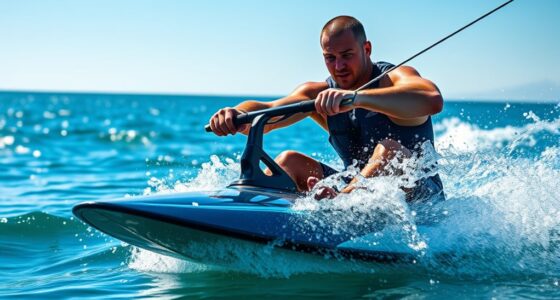To guarantee safe night riding, install bright front and rear lights with multiple modes, and keep them charged and clean. Wear reflective gear and attach visibility flags to your bike to catch drivers’ eyes from afar. Position your lights to shine from multiple angles and regularly check they’re working properly. Use techniques like reducing speed and signaling clearly. For more expert tips on maximizing your visibility and safety gear, continue exploring your options.
Key Takeaways
- Use bright, rechargeable front and rear lights with multiple modes, securely installed and regularly maintained for maximum visibility.
- Wear reflective gear and attach visibility flags to increase road presence from multiple angles.
- Position lights to be seen from various directions, keeping them clean, charged, and functioning properly before each ride.
- Reduce speed, scan the road with bike lights, and stay alert to obstacles and surface changes in low-light conditions.
- Conduct pre-ride safety checks, incorporate reflective accessories, and prioritize proper lighting setup for comprehensive night safety.

Riding at night presents unique challenges, so setting up your bike properly is crucial for safety and performance. One of the most critical aspects is guaranteeing you have the right lighting accessories. Good lighting not only illuminates the road ahead but also makes you more visible to others. Invest in a bright, reliable front light that offers multiple modes, like steady beam and flashing, so you can adapt to different conditions. A powerful rear light is equally important; it should be visible from a significant distance, even in low-light scenarios. Consider lights with rechargeable batteries for convenience and consistent brightness. When choosing lighting accessories, focus on durability and weather resistance to ensure they function well in rain or fog. Properly installed, these lights can dramatically improve your visibility techniques, helping you see obstacles and signal your presence effectively.
In addition to your bike’s lights, think about supplementary visibility techniques. Wearing reflective gear, such as vests, ankle bands, or strips on your helmet, boosts your presence on the road. Reflective materials catch the light from passing vehicles, making you stand out even if your bike’s lights momentarily falter. Position your lights strategically—placing reflective elements where they’ll catch the eye from different angles can make a big difference. Also, consider adding a visibility flag to your bike, especially if you’re riding in areas with heavy traffic or during low-visibility conditions. These flags wave visibly and serve as an extra alert to drivers, giving them more time to react.
Beyond lighting accessories and reflective gear, riding techniques are essential for safety. Slow down, especially in poorly lit areas or unfamiliar terrain. Use your lights to scan the road ahead rather than just relying on your peripheral vision. Keep your hands on the handlebars and stay alert for sudden obstacles or changes in the surface. Signal your intentions clearly with hand signals or brake lights if your bike is equipped with them. Always check your lights and reflectors before each ride to guarantee they’re functioning properly. Maintaining your bike’s visibility by keeping lights clean and batteries charged is a simple but effective safety measure.
Frequently Asked Questions
What Are the Best Types of Lights for Night Riding?
When choosing the best lights for night riding, you want bright, reliable options that suit your bike maintenance routine and the road conditions you’ll face. Look for powerful LED headlights and taillights that offer steady beams and multiple modes for visibility. Consider rechargeable lights for convenience, and always make certain your lights are securely mounted. Good lighting improves safety and makes your ride more enjoyable, especially on poorly lit or unpredictable roads.
How Should I Position My Flags for Maximum Visibility?
Think of your flags like a lighthouse guiding ships; their visibility depends on strategic placement. To optimize visibility, position your flags high on your bike or vehicle, ensuring they’re unobstructed and flutter openly in the wind. Use bright colors or reflective materials, and angle them slightly outward. Proper flag positioning maximizes visibility, helping others see you from a distance and keeping you safe during night rides.
What Safety Gear Is Essential for Night Riding?
For night riding, you need essential safety gear like a helmet that emphasizes safety and reflective clothing to boost visibility. Wearing a helmet ensures protection in case of falls, while reflective gear helps others see you clearly in low light. Make sure your helmet fits well, and your reflective clothing is visible from all angles. Always stay alert and wear gear designed for night conditions to keep safe on your ride.
Are There Legal Requirements for Lighting and Flags?
You need to guarantee legal compliance with lighting and flag regulations when night riding. Many areas require you to have functional front and rear lights that are visible from a distance to stay safe and avoid fines. Additionally, flag regulations often specify the size, color, and placement of flags to increase visibility. Always check local laws to meet these requirements, and don’t forget that following them helps protect you and others on the road.
How Can I Improve My Overall Night Riding Visibility?
To improve your night riding visibility, you should wear reflective clothing that catches light from vehicles and streetlights. Additionally, use a horn and bell to alert others of your presence, especially in low-light conditions. Make sure your bike is equipped with bright front and rear lights, and consider adding reflective strips or stickers. These measures help guarantee you’re seen and heard, considerably enhancing your safety during night rides.
Conclusion
Don’t let darkness hold you back from enjoying your rides. With the right lights, flags, and safety gear, you can ride confidently and safely through the night. Sure, some might think it’s risky or unnecessary, but imagine the freedom of riding under the stars, feeling alive and connected. Embrace the night, stay visible, and keep yourself protected—because nothing beats the thrill of night riding, knowing you’re prepared for every adventure ahead.










